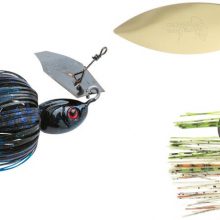This article may contain affiliate links. If you make a purchase after clicking on a link we may earn a small commission at no extra cost to you. As an Amazon Associate, I earn from qualifying purchases.
Chatterbait vs Spinnerbait

Chatterbait vs spinnerbait – just how different are these lures in terms of design and fishing applications?
Most anglers can tell the difference between an chatterbait and a spinnerbait just by looking at them.
Where the biggest confusion lies is where and when is the best way to fish them.
Both are fished on fairly similar tackle and both do create quite a bit of disturbance especially when they are fished right under the water surface.
If you are not overly familiar with how each lure is constructed then below we describe the exact make up of each lure and how it swims:
- Chatterbait – A chatterbait is also known as a bladed swim jig and the two terms can be used interchangeably. Chatterbaits have a semi-hexagonal blade that is mounted in front of a swim jig. It has a jig head and a trailing skirt. The blade does not spin a full 360 degrees around the front of the chatterbait. Instead it vibrates back and forth from side to side but never fully spins. It also gives off a very distinctive sound.
- Spinnerbait – A spinnerbait has a bent wire construction at 90 degrees. One on side of the wire there is a jig head and a trailing skirt. One the other side there is a spinning blade or often multiple blades. The blades are free to spin fully around the wire and give off a really solid vibration and flash in the water.
Chatterbait vs Spinnerbait
The main difference between a chatterbait and a spinnerbait is the types of blades used in their construction and how those blades spin.
On a chatterbait the blade is a hexagonal shape and is mounted on the front of the lure. The blade vibrates from side to side but never fully spins around and around.
Whereas on a spinnerbait the blade is a more traditional type of spinner blade such as a willow or Colorado blade.
The spinnerbait has the blades mounted out to the side of the jig head and skirt compared to a chatterbait that has the blade mounted directly in front of the jig head.
When to Fish Them
The best time to choose a chatterbait is when you are working in and around heavy weeds. Chatterbaits really do excel here and you can fish a chatterbait over the tops of weeds by either burning them quickly or using a more stop start technique.
That vibrating blade can draw bass out from cover and they will smash a chatterbait hard from below.
Spinnerbaits work really well on very windy days or in darker waters.On really windy days some topwater lures can perform poorly but fishing a spinnerbait just below the surface and your chances will increase greatly.
The give off a lot of vibration and flash from their spinning blades so any time you need to really attract bass in because of poor light or dark waters then the spinnerbait is one of the better options.
Spinnerbaits are of the few lures that are actually quite productive year round. Although I prefer a chatterbait over a spinnerbait during summer months.
Tackle Considerations
Both these types of lures can be fished on very similar tackle.
Light spinning gear is not the best choice of setup here. A good quality baitcasting rod and reel will be the better option.
Line choice will also be pretty similar.
A spinnerbait rod needs a decent backbone so a medium/heavy power rating is usually best and a fast action.
The same too can be said for when you are choosing a chatterbait setup, most chatterbait rods will have a fast action.
Occasionally you will see one used with a more moderate action, this is done when using very large chatterbaits especially ones with long trailers as you might want to delay the hook-set slightly.
